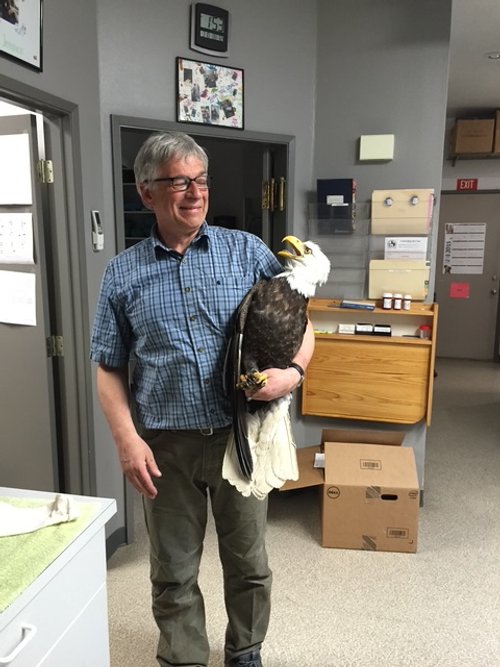Q&A with Dave Parent
Dave Parent is a semi-retired veterinarian who is well known on Whidbey for his three decades of treating wildlife at the Useless Bay Animal Clinic. While Dave has been leading field trips for Whidbey Audubon for many years, he only recently joined the board. We talked with Dave about his interest in animals and his work with Audubon.
What brought you to Whidbey Island?
I came to Whidbey from Seattle in 1990, a few years after graduating from veterinary school, and bought the Useless Bay Animal Clinic. I sold the practice in 2021, but I still fill in for the vets periodically and help with the wildlife. Right now, I’m the only vet working with wildlife on Whidbey.
What is your advice to someone who finds an injured bird?
Don’t expect a happy ending. That’s rarely the case. If you can pick up a bird, it’s usually very sick. As a vet, my job is to look at the animal and say: Can this bird survive? Is this a situation where the rehab is worth the money? If the answer is yes, then I refer the animal to Wolf Hollow on San Juan Island or PAWS wildlife facility in Snohomish.
Dave says that unlike many birds that people brought to his clinic, this eagle was able to be released the next day.
Where did your interest in birds originate?
I started learning about birds from my mother. When I was a boy, she had the Peterson Field Guide to Birds. I still have her copy. Our identification skills weren't that great, but we tried.
I’ve always been interested in learning about animals of all kinds. In addition to treating birds and other wildlife, I’ve been able to use my veterinary experience to work on research projects in Alaska and Madagascar and in Olympic National Park.
How did you start leading trips with Audubon?
About 15 years ago, Joe Sheldon, a longtime Audubon leader and birding buddy, asked me if I wanted to run some field trips. I said, “Sure, but I’m not going to do the usual drive somewhere, walk 100 feet, get back in the car kind of trip…We’re going to do some crazy stuff!”
In those early days, we took a backpacking trip to the coast and a couple of trips to Mt. Rainier that involved some strenuous hikes. These days, most of our trips aren’t quite as demanding. We have an aging population on Whidbey, people have aches and pains. I have those too! But I still like to get out there.
You’ve been leading field trips for a long time! What keeps you doing it?
It’s simple: I love to show people cool wildlife. I try to keep the trips light and have fun. When I can show someone a life bird—a bird they have never seen before—I get almost as excited as they do! If we have a nubie, somebody who doesn’t know the difference between a crow and a robin, that’s all the better.
Whidbey Audubon runs more than 20 trips every year, and they are very well attended. What motivates people to participate?
We have a lot of regular attendees. I see familiar faces every time I lead a trip. I think people come back because our trip leaders are superb teachers. And people like the sense of camaraderie. Going on our field trips is almost like being in a special club.
What are your favorite places to go birding?
Locally, some of the spots I like are Deer Lagoon, the Keystone area, Swantown Lake and West Beach.
I look at birds and other wildlife internationally too. We just got back from Bhutan. That was a wonderful trip. I saw more than 300 species of birds and enjoyed the Tibetan Buddhist culture. Earlier this year we were in Ecuador. There are a lot of places on my list, and there is wildlife everywhere.
And your favorite birds?
Black Swifts are one. Gyrfalcon also. I really like seabirds, including Albatrosses. I like to go to Westport once a year during the season and watch them.
You’ve devoted a lot of time to Whidbey Audubon. Why do you think the organization’s work is so valuable?
Through our field trips and other educational activities, Audubon is giving people opportunities to learn about wildlife and the environment. And the more people learn, the more advocates we are going to have. Ultimately, that is how we will improve the way that we treat the Earth.

